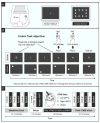Causal evidence supporting functional dissociation of verbal and spatial working memory in the human dorsolateral prefrontal cortex
- PMID: 24713032
- PMCID: PMC4043922
- DOI: 10.1111/ejn.12584
Causal evidence supporting functional dissociation of verbal and spatial working memory in the human dorsolateral prefrontal cortex
Abstract
The human dorsolateral prefrontal cortex (dlPFC) is crucial for monitoring and manipulating information in working memory, but whether such contributions are domain-specific remains unsettled. Neuroimaging studies have shown bilateral dlPFC activity associated with working memory independent of the stimulus domain, but the causality of this relationship cannot be inferred. Repetitive transcranial magnetic stimulation (rTMS) has the potential to test whether the left and right dlPFC contribute equally to verbal and spatial domains; however, this is the first study to investigate the interaction of task domain and hemisphere using offline rTMS to temporarily modulate dlPFC activity. In separate sessions, 20 healthy right-handed adults received 1 Hz rTMS to the left dlPFC and right dlPFC, plus the vertex as a control site. The working memory performance was assessed pre-rTMS and post-rTMS using both verbal-'letter' and spatial-'location' versions of the 3-back task. The response times were faster post-rTMS, independent of the task domain or stimulation condition, indicating the influence of practice or other nonspecific effects. For accuracy, rTMS of the right dlPFC, but not the left dlPFC or vertex, led to a transient dissociation, reducing spatial, but increasing verbal accuracy. A post-hoc correlation analysis found no relationship between these changes, indicating that the substrates underlying the verbal and spatial domains are functionally independent. Collapsing across time, there was a trend towards a double dissociation, suggesting a potential laterality in the functional organisation of verbal and spatial working memory. At a minimum, these findings provide human evidence for domain-specific contributions of the dlPFC to working memory and reinforce the potential of rTMS to ameliorate cognition.
Keywords: dorsolateral prefrontal cortex; functional neuroanatomy; functional specialisation; repetitive transcranial magnetic stimulation; working memory.
© 2014 Federation of European Neuroscience Societies and John Wiley & Sons Ltd.
Conflict of interest statement
The authors declare no competing financial interests.
Figures




Similar articles
-
Lateralized contribution of prefrontal cortex in controlling task-irrelevant information during verbal and spatial working memory tasks: rTMS evidence.Neuropsychologia. 2008;46(7):2056-63. doi: 10.1016/j.neuropsychologia.2008.02.003. Epub 2008 Feb 8. Neuropsychologia. 2008. PMID: 18336847
-
Unilateral repetitive transcranial magnetic stimulation differentially affects younger and older adults completing a verbal working memory task.J Neurol Sci. 2018 Jan 15;384:15-20. doi: 10.1016/j.jns.2017.10.021. Epub 2017 Oct 20. J Neurol Sci. 2018. PMID: 29249371
-
Effects of repetitive transcranial magnetic stimulation on memory subtypes: a controlled study.Neuropsychologia. 2003;41(14):1877-83. doi: 10.1016/s0028-3932(03)00131-3. Neuropsychologia. 2003. PMID: 14572521 Clinical Trial.
-
Working memory improvement with non-invasive brain stimulation of the dorsolateral prefrontal cortex: a systematic review and meta-analysis.Brain Cogn. 2014 Apr;86:1-9. doi: 10.1016/j.bandc.2014.01.008. Epub 2014 Feb 8. Brain Cogn. 2014. PMID: 24514153 Review.
-
Systematic Review and Meta-Analysis of High-Frequency rTMS over the Dorsolateral Prefrontal Cortex .on Chronic Pain and Chronic-Pain-Accompanied Depression.ACS Chem Neurosci. 2022 Sep 7;13(17):2547-2556. doi: 10.1021/acschemneuro.2c00395. Epub 2022 Aug 15. ACS Chem Neurosci. 2022. PMID: 35969469 Review.
Cited by
-
Altered morphological characteristics and structural covariance connectivity associated with verbal working memory performance in ADHD children.Br J Radiol. 2023 Nov;96(1151):20230409. doi: 10.1259/bjr.20230409. Epub 2023 Oct 3. Br J Radiol. 2023. PMID: 37750842 Free PMC article.
-
Augmentation of working memory training by transcranial direct current stimulation (tDCS).Sci Rep. 2017 Apr 21;7(1):876. doi: 10.1038/s41598-017-01055-1. Sci Rep. 2017. PMID: 28432349 Free PMC article.
-
Multielectrode Transcranial Electrical Stimulation of the Left and Right Prefrontal Cortices Differentially Impacts Verbal Working Memory Neural Circuitry.Cereb Cortex. 2020 Apr 14;30(4):2389-2400. doi: 10.1093/cercor/bhz246. Cereb Cortex. 2020. PMID: 31799616 Free PMC article.
-
Systemic klotho is associated with KLOTHO variation and predicts intrinsic cortical connectivity in healthy human aging.Brain Imaging Behav. 2017 Apr;11(2):391-400. doi: 10.1007/s11682-016-9598-2. Brain Imaging Behav. 2017. PMID: 27714549 Free PMC article.
-
Language boosting by transcranial stimulation in progressive supranuclear palsy.Neurology. 2019 Aug 6;93(6):e537-e547. doi: 10.1212/WNL.0000000000007893. Epub 2019 Jul 3. Neurology. 2019. PMID: 31270217 Free PMC article. Clinical Trial.
References
-
- Abler B, Walter H, Wunderlich A, Grothe J, Schönfeldt-Lecuona C, Spitzer M, Herwig U. Side effects of transcranial magnetic stimulation biased task performance in a cognitive neuroscience study. Brain Topogr. 2005;17:193–196. - PubMed
-
- Baayen RH, Davidson DJ, Bates DM. Mixed-effects modeling with crossed random effects for subjects and items. J Mem Lang. 2008;59:390–412.
-
- Baddeley The episodic buffer: a new component of working memory? Trends Cogn Sci. 2000;4:417–423. - PubMed
-
- Baddeley AD, Hitch G. Working Memory. Academic Press; 1974. pp. 47–89.
Publication types
MeSH terms
Grants and funding
LinkOut - more resources
Full Text Sources
Other Literature Sources

